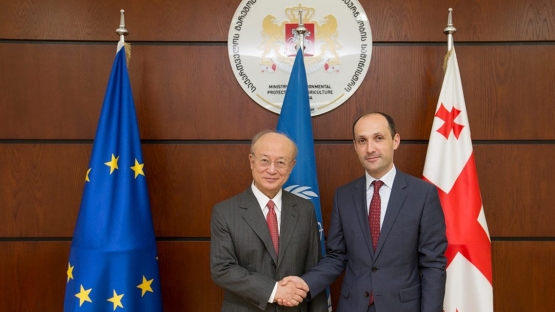IAEA Director General Reviews Use of Nuclear Technologies in Georgia
IAEA Director General Yukiya Amano and Levan Davitashvili,
Georgia's Minister of Environmental Protection and Agriculture,
discussed IAEA's support to the country, Tbilisi, 16-17 April 2018.
(Photo: M. Krause/IAEA)
IAEA Director General met President Giorgi Margvelashvili of
Georgia this week, following the country’s deposit, on 10 April, of its
Instrument of Accession to the Convention on Assistance in the Case of a
Nuclear Accident or Radiological Emergency.
“I welcome Georgia’s adherence to this important treaty, and contribution to nuclear safety globally,” Mr Amano said.
Adopted after the Chernobyl nuclear plant accident, the Convention sets out an international framework for co-operation among States Parties and with the IAEA to facilitate prompt assistance and support in the event of nuclear accidents or radiological emergencies. So far, the Convention has 116 Parties.
Mr Amano also met Levan Davitashvili, Minister of Environmental Protection and Agriculture, and Vasil Gedevanishvili, Head of the Agency of Nuclear and Radiation Safety (ANRS), which is responsible for regulatory oversight in the country.
Georgia uses radioactive sources in medicine and industry and operates radioactive waste management facilities. With the support of the IAEA, it has decommissioned its only research reactor, an IRT-type at the State University of Tbilisi. The IAEA is also helping the country establish a laboratory that will provide environmental monitoring services using nuclear technologies.
Georgia’s authorities are exploring different options for radioactive waste disposal, in particular a central waste treatment and storage facility. In recent years, the Government and ANRS, with assistance from the IAEA, introduced new safety regulations and increased the number of regulatory inspections.
To assess the regulatory safety framework in the country, an IAEA Integrated Regulatory Review Service (IRRS) team concluded a 10-day mission to the country in February this year. The team found that Georgia had made significant progress in strengthening its regulatory framework for nuclear and radiation safety. It also pointed to challenges ahead as Georgia seeks to achieve further progress.
These challenges include the need to develop competencies for safety professionals, separate the roles of the regulatory body and the operator of radioactive waste facilities, and define a plan for radioactive waste disposal.
IRRS missions are designed to strengthen the effectiveness of the national safety regulatory infrastructure, while recognizing the responsibility of each State to ensure nuclear and radiation safety.
Over the years, the IAEA has been supporting Georgia through its technical cooperation programme in other areas as well, including nuclear medicine, cancer treatment, non-destructive testing and water resource management. A new field they are tapping into is the rapid detection of animal diseases with the use of molecular diagnostic tools. Mr Amano’s visit coincides with the first regional technical cooperation project meeting on this topic in Tbilisi.
“I welcome Georgia’s adherence to this important treaty, and contribution to nuclear safety globally,” Mr Amano said.
Adopted after the Chernobyl nuclear plant accident, the Convention sets out an international framework for co-operation among States Parties and with the IAEA to facilitate prompt assistance and support in the event of nuclear accidents or radiological emergencies. So far, the Convention has 116 Parties.
Mr Amano also met Levan Davitashvili, Minister of Environmental Protection and Agriculture, and Vasil Gedevanishvili, Head of the Agency of Nuclear and Radiation Safety (ANRS), which is responsible for regulatory oversight in the country.
Georgia uses radioactive sources in medicine and industry and operates radioactive waste management facilities. With the support of the IAEA, it has decommissioned its only research reactor, an IRT-type at the State University of Tbilisi. The IAEA is also helping the country establish a laboratory that will provide environmental monitoring services using nuclear technologies.
Georgia’s authorities are exploring different options for radioactive waste disposal, in particular a central waste treatment and storage facility. In recent years, the Government and ANRS, with assistance from the IAEA, introduced new safety regulations and increased the number of regulatory inspections.
To assess the regulatory safety framework in the country, an IAEA Integrated Regulatory Review Service (IRRS) team concluded a 10-day mission to the country in February this year. The team found that Georgia had made significant progress in strengthening its regulatory framework for nuclear and radiation safety. It also pointed to challenges ahead as Georgia seeks to achieve further progress.
These challenges include the need to develop competencies for safety professionals, separate the roles of the regulatory body and the operator of radioactive waste facilities, and define a plan for radioactive waste disposal.
IRRS missions are designed to strengthen the effectiveness of the national safety regulatory infrastructure, while recognizing the responsibility of each State to ensure nuclear and radiation safety.
Over the years, the IAEA has been supporting Georgia through its technical cooperation programme in other areas as well, including nuclear medicine, cancer treatment, non-destructive testing and water resource management. A new field they are tapping into is the rapid detection of animal diseases with the use of molecular diagnostic tools. Mr Amano’s visit coincides with the first regional technical cooperation project meeting on this topic in Tbilisi.


No comments:
Post a Comment